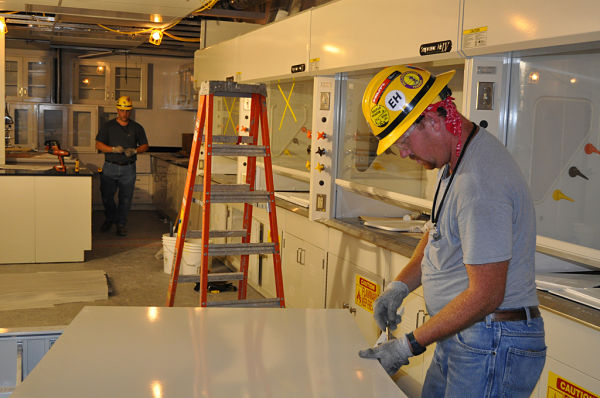What do bunnies, coins and PCR have in common? They all have tails! (ha ha!)
Thermal asymmetric interlaced PCR or TAIL-PCR is used to sequence and analyse unknown DNA fragments that are adjacent to known sequences. Think of it as being rather like networking. You know you want to get to know someone so you ask a mutual friend to introduce you. This technique is great for finding out the regulatory sequences of a gene and to identify insertion sites in large genome tagging populations.
TAIL-PCR makes use of “nested” or “specific” primers. These primers are not so-named because of a tendency to roost in intertwined branches, they’re just normal run-of-the-mill primers, but this does make for a rather curious mental image.
In normal PCR, unless your primers are extremely specific, some non-specific binding and amplification of non-target sequences is very possible (even with hotstart PCR). Nested primers to the rescue! These primers bind within the sequence of the two “normal” primers and so “nest” cosily. This gives them far better discriminatory powers.
So how does bunn- I mean TAIL-PCR work?
TAIL-PCR starts with thermal cycles of PCR and a pair of primers that are relatively far apart. Next, an additional primer or pair of primers is added (our nested friends) which bind the sequence between the first set of primers, also called the “outer”, “arbitrary degenerate” (AD) or “border” primers. They are added as higher concentrations than the outer primers so that after a few cycles they rule the roost and are producing more PCR product than the other primers. This technique comes in handy when we want to map where transfer DNA has inserted itself into the genome.
The two primer types have differing annealing temperatures. The PCR program incorporates intermittent outer primer-favouring favouring cycles (called the “primary reactions”) between nested primer-favoured reactions (or “secondary reactions”). This makes sequences bordered by a specific primer on one end and an AD primer on the other. The product sequences are then amplified in subsequent rounds of PCR (called the “tertiary reactions”) using another set of nested primers.
Wait, what are AD primers? And why are we AD-ding them?!
AD primers bind close to the known sequences. By using these less picky primers you increase the number of sequences that contain the target sequence and are thus reducing the amount of non-target binding. When there are small mutations, super particular primers are less likely to bind but these guys are a little dopey and can’t tell the difference as well.
Not too complicated is it!
Now that the concept has been explained, let’s get into the details.
In your searches for a simple explanation of TAIL-PCR, you probably saw the word “stringency” a lot and thought to yourself “say what?”
Every time you see the word, just think of temperature. High stringency just means higher temperatures are used (63°C). High stringency cycles generate specific binding events. Reduced or medium stringency (44°C) and low stringency (30°C) are also used. Lower stringency is associated with less picky binding and higher stringency with more specific primers.
Three specific primers are used for the three phases of the PCR, the primary secondary and tertiary phases. These are normal PCR primers that do there thing at about 60°C and are roughly 20–35 nucleotides in length. One AD primer is used and it is 8–12 nucleotides in length that hop, skips and jumps at about 45°C. All primers are used with their reverse counterparts.
But where are our nested friends in all of this??!
The specific primers used consist of a terminal primer (for the primary phase) and then two nested primers (for the secondary and tertiary phases). The AD primer is going to bind the adjacent unknown sequence and the specific primers will bind the known sequence.
The nitty gritty of the PCR program looks like this:
| Category | Typical number of copies per bacterial cell |
|---|---|
| Low copy (e.g. pBR22 and derivatives) | 15–20 copies per cell |
| Medium copy | 20–100 copies per cell |
| High copy (e.g. pUC18, pUC19 vectors) | 500–700 copies per cell |
Secondary reaction: here, one of the nested primers and the AD primer pairs are used. Here, 10–15 TAILING events are used. This makes moderate amounts of the unknown sequence of interest (due to the reduced stringency cycles) but the AD and specific primers together make a specific product in high amounts. Again the products are diluted 1000-fold and act as the ingredients for the tertiary reaction.Primary reaction: your terminal primer pair (the forward and reverse sequences) and the AD primer pair are used. Five stringency cycles followed by a reduced stringency cycle are used. Next, is a TAILING phase. This involves two high stringency cycles followed by one reduced stringency cycle and is repeated 10–12 times. This creates three products. Firstly, our known sequence copied by the terminal specific primer produced in the high stringency phases and is produced in large amounts. Secondly, reduced stringency cycles favouring AD primer binding to various parts of the unknown sequence of interest and is made in moderate amounts. Thirdly, a product is made from AD primers binding the product of high stringency cycles during reduced stringency cycles but this is in very small amounts. These products are diluted 1000–fold and serve as the templates for the secondary reaction.
Tertiary reaction: the second nested primer and the AD primer are used and again only TAILING events are used here. This creates high amounts of the product you want and negligible non-specific products.
Yay!
The products may be analyzed in by agarose gel electrophoresis after the tertiary reaction, which may be eluted and be used for further processes such as cloning and sequencing.







